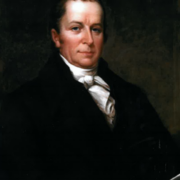Historic Selinsgrove
First Peoples
The original inhabitants of what is now the borough of Selinsgrove were Native Americans called the Shenk’s Ferry culture. They were active on the west side of the Susquehanna River up to the 1500s, when they were displaced by the Susquehannocks. This group, too, was disrupted by warfare with other Native peoples and left the area in the 1670s. For the next eighty years, the land that became Snyder County was used as hunting and fishing grounds by various Native American groups allied with the Haudenosaunee (Iroquois) to the north.

An 1830 map showing the location of George Gabriel’s property. Penn’s Creek had been diverted in the previous decade, now bending to the south instead of flowing eastward to the river. From Canal Map Books, PA State Archives. See a modern overlay map HERE.
“Gabriel’s Improvement”
In 1754, George Gabriel became the first European to build a permanent settlement in this area on the west side of the Susquehanna River. The two-acre settlement, marked on colonial maps as “Gabriel’s Improvement,” was located “at the mouth of Penn’s Creek,” which was then about four miles north of the creek’s present-day mouth. His farm and homestead became a trading post, a grist mill, a tavern, and an all-purpose community center for European squatters before the French and Indian War and legal settlers afterward.

The Isle of Que as shown before construction of the canal, in the 1810s. From Melish-Whiteside maps, PA State Archives
Legendary Dreams
A legend passed down by generations of central Susquehanna Valley inhabitants concerned ownership of the Isle of Que. In the 1730s and 1740s, the Native American leader Shikellamy, who governed the Native groups in the region on behalf of the Haudenosaunee (Iroquois), worked closely with Conrad Weiser. Weiser was an interpreter and negotiator for the colony of Pennsylvania. The legend has it that Shikellamy manipulated Weiser into giving him his prized Pennsylvania rifle by claiming that he had dreamed that it would happen. Not to be outdone, Weiser mentioned his own dream, in which Shikellamy had given him the Isle of Que. Both men played their part, and the story ends with Shikellamy solemnly saying, “Let’s never dream again.” Weiser became a major land owner on the west side of the river. The southern part of what is now Selinsgrove was known as Weisertown after the Revolution.
Names to Remember
ANTHONY SELIN
In May 1776, a Swiss soldier of fortune named Anthony Selin captained an independent corps on order of General George Washington. Selin served in a support role during the Revolutionary War, including command of a “pioneer” detachment to clear the path for the Sullivan Expedition in 1779. This was a scorched-earth campaign against the Haudenosaunee (Iroquois) in what is now upstate New York. One historian refers to him as a “Swiss adventurer in the Continental Army.” Selin resigned his commission and moved to this area in 1783. By the late 1780s, he operated a store and mill on the upper part of the Isle of Que. Tax records show that he and his brother-in-law, Simon Snyder, owned one slave and forty acres of land.
SIMON SNYDER
Simon Snyder was one of the Susquehanna Valley’s most influential residents. Born in Lancaster in 1759, Snyder relocated to what is now Selinsgrove in the 1780s. He ran a mill and started other business ventures with his brother-in-law, Anthony Selin. Snyder entered politics during these years and served in Pennsylvania’s General Assembly. Then, remarkably, a man with little formal education and no family political connections rose to serve three terms as Pennsylvania’s third Governor (1808-1817). His 1816 home on Market Street currently houses the Selin’s Grove Brewing Company. READ MORE…
The Canal
For much of the 1800s, Selinsgrove was a canal town. The town was a key stop along the Susquehanna Division of the Pennsylvania Canal. Initial construction took place between 1827 and 1829. The typical navigation season for the canal was March to November, but bad weather complicated that schedule many years. Several stores lined the canal near Pine Street, catering to the workers who floated through town. The canal closed for good in 1901. The end came as no surprise to locals. In 1900, the Selinsgrove Times reported, “It is badly out of repair, its condition preventing traffic, and business has been unprofitable for the past ten years.” Today, the US 11/15 bypass follows the general path of the canal along Penn’s Creek.
Susquehanna University
There is good reason Susquehanna University is located in Selinsgrove. Community visionaries saw the benefit of an institution of higher learning and led the drive for local support. They raised $22,500 to bring the Missionary Institute (as it was known when it was first chartered in 1858) to town. The successful fundraising led to Selinsgrove Hall being named in honor of the community, which had officially become a borough five years earlier. In 1895, the institution became Susquehanna University.




